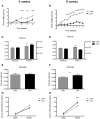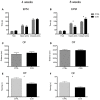An efficient chronic unpredictable stress protocol to induce stress-related responses in C57BL/6 mice
- PMID: 25698978
- PMCID: PMC4313595
- DOI: 10.3389/fpsyt.2015.00006
An efficient chronic unpredictable stress protocol to induce stress-related responses in C57BL/6 mice
Abstract
Exposure to chronic stress can have broad effects on health ranging from increased predisposition for neuropsychiatric disorders to deregulation of immune responses. The chronic unpredictable stress (CUS) protocol has been widely used to study the impact of stress exposure in several animal models and consists in the random, intermittent, and unpredictable exposure to a variety of stressors during several weeks. CUS has consistently been shown to induce behavioral and immunological alterations typical of the chronic stress-response. Unfortunately C57BL/6 mice, one of the most widely used mouse strains, due to the great variety of genetically modified lines, seem to be resistant to the commonly used 4-week-long CUS protocol. The definition of an alternative CUS protocol allowing the use of C57BL/6 mice in chronic stress experiments is a need. Here, we show that by extending the CUS protocol to 8 weeks is possible to induce a chronic stress-response in C57BL/6 mice, as revealed by abrogated body weight gain, increased adrenals weight, and an overactive hypothalamic-pituitary-adrenal axis with increased levels of serum corticosterone. Moreover, we also observed stress-associated behavioral alterations, including the potentiation of anxious-like and depressive-like behaviors and a reduction of exploratory behavior, as well as subtle stress-related changes in the cell population of the thymus and of the spleen. The present protocol for C57BL/6 mice consistently triggers the spectrum of CUS-induced changes observed in rats and, thus, will be highly useful to researchers that need to use this particular mouse strain as an animal model of neuropsychiatric disorders and/or immune deregulation related to CUS.
Keywords: CUS; anxiety; chronic stress; depressive-like behavior; immune dysfunction; neuropsychiatric disorders; social defeat.
Figures







Similar articles
-
5HT3 receptor antagonist (ondansetron) reverses depressive behavior evoked by chronic unpredictable stress in mice: modulation of hypothalamic-pituitary-adrenocortical and brain serotonergic system.Pharmacol Biochem Behav. 2014 Sep;124:129-36. doi: 10.1016/j.pbb.2014.05.024. Epub 2014 Jun 6. Pharmacol Biochem Behav. 2014. PMID: 24909071
-
Increased sensitivity to the effects of chronic social defeat stress in an innately anxious mouse strain.Neuroscience. 2011 Sep 29;192:524-36. doi: 10.1016/j.neuroscience.2011.04.054. Epub 2011 May 27. Neuroscience. 2011. PMID: 21635938
-
Role of corticosterone in anxiety- and depressive-like behavior and HPA regulation following prenatal alcohol exposure.Prog Neuropsychopharmacol Biol Psychiatry. 2019 Mar 2;90:1-15. doi: 10.1016/j.pnpbp.2018.10.008. Epub 2018 Oct 24. Prog Neuropsychopharmacol Biol Psychiatry. 2019. PMID: 30367959 Free PMC article.
-
Lack of vasopressin does not prevent the behavioural and endocrine changes induced by chronic unpredictable stress.Brain Res Bull. 2011 Jan 15;84(1):45-52. doi: 10.1016/j.brainresbull.2010.09.014. Epub 2010 Oct 12. Brain Res Bull. 2011. PMID: 20946941
-
The consequences of adolescent chronic unpredictable stress exposure on brain and behavior.Neuroscience. 2013 Sep 26;249:232-41. doi: 10.1016/j.neuroscience.2012.09.018. Epub 2012 Sep 20. Neuroscience. 2013. PMID: 23000538 Review.
Cited by
-
Juvenile stress induces behavioral change and affects perineuronal net formation in juvenile mice.BMC Neurosci. 2018 Jul 16;19(1):41. doi: 10.1186/s12868-018-0442-z. BMC Neurosci. 2018. PMID: 30012101 Free PMC article.
-
Chronic Stress Does Not Influence the Survival of Mouse Models of Glioblastoma.Front Oncol. 2022 Mar 25;12:856210. doi: 10.3389/fonc.2022.856210. eCollection 2022. Front Oncol. 2022. PMID: 35402232 Free PMC article.
-
Mesenchymal stromal cell biotherapy for Parkinson's disease premotor symptoms.Chin Neurosurg J. 2023 Oct 13;9(1):28. doi: 10.1186/s41016-023-00338-z. Chin Neurosurg J. 2023. PMID: 37833807 Free PMC article. Review.
-
Anxiolytic Effect of Carvedilol in Chronic Unpredictable Stress Model.Oxid Med Cell Longev. 2022 Aug 19;2022:6906722. doi: 10.1155/2022/6906722. eCollection 2022. Oxid Med Cell Longev. 2022. PMID: 36035219 Free PMC article.
-
Cellular senescence as a driver of cognitive decline triggered by chronic unpredictable stress.Neurobiol Stress. 2021 May 18;15:100341. doi: 10.1016/j.ynstr.2021.100341. eCollection 2021 Nov. Neurobiol Stress. 2021. PMID: 34095365 Free PMC article.
References
LinkOut - more resources
Full Text Sources
Other Literature Sources

